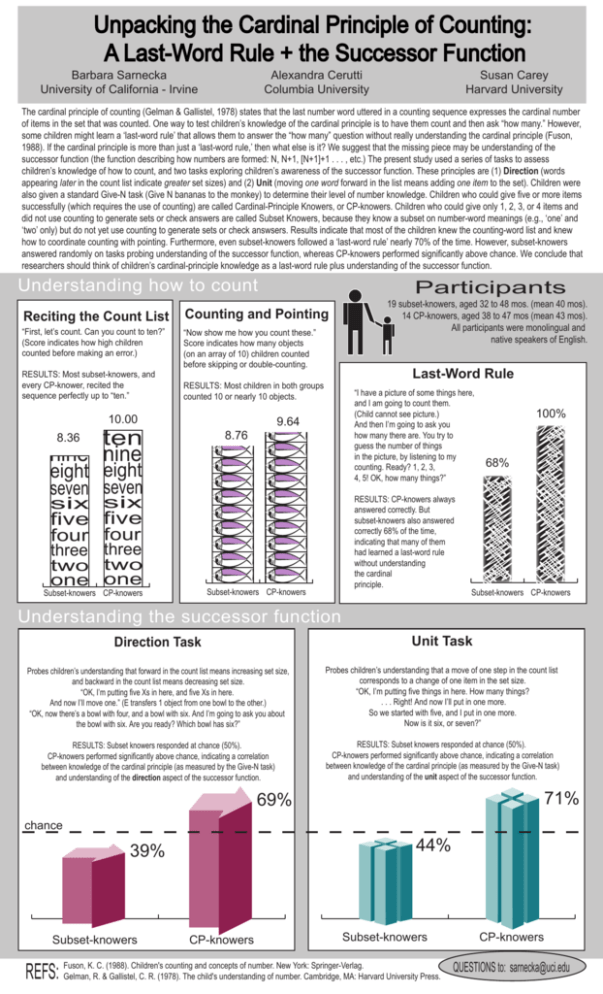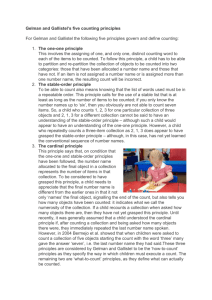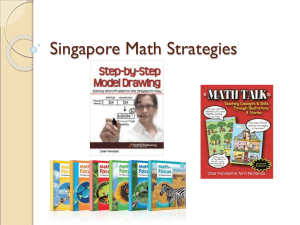Unpacking the Cardinal Principle of Counting
advertisement

Unpacking the Cardinal Principle of Counting: A Last-Word Rule + the Successor Function Barbara Sarnecka University of California - Irvine Alexandra Cerutti Columbia University Susan Carey Harvard University The cardinal principle of counting (Gelman & Gallistel, 1978) states that the last number word uttered in a counting sequence expresses the cardinal number of items in the set that was counted. One way to test children’s knowledge of the cardinal principle is to have them count and then ask “how many.” However, some children might learn a ‘last-word rule’ that allows them to answer the “how many” question without really understanding the cardinal principle (Fuson, 1988). If the cardinal principle is more than just a ‘last-word rule,’ then what else is it? We suggest that the missing piece may be understanding of the successor function (the function describing how numbers are formed: N, N+1, [N+1]+1 . . . , etc.) The present study used a series of tasks to assess children’s knowledge of how to count, and two tasks exploring children’s awareness of the successor function. These principles are (1) Direction (words appearing later in the count list indicate greater set sizes) and (2) Unit (moving one word forward in the list means adding one item to the set). Children were also given a standard Give-N task (Give N bananas to the monkey) to determine their level of number knowledge. Children who could give five or more items successfully (which requires the use of counting) are called Cardinal-Principle Knowers, or CP-knowers. Children who could give only 1, 2, 3, or 4 items and did not use counting to generate sets or check answers are called Subset Knowers, because they know a subset on number-word meanings (e.g., ‘one’ and ‘two’ only) but do not yet use counting to generate sets or check answsers. Results indicate that most of the children knew the counting-word list and knew how to coordinate counting with pointing. Furthermore, even subset-knowers followed a ‘last-word rule’ nearly 70% of the time. However, subset-knowers answered randomly on tasks probing understanding of the successor function, whereas CP-knowers performed significantly above chance. We conclude that researchers should think of children’s cardinal-principle knowledge as a last-word rule plus understanding of the successor function. Understanding how to count Participants Reciting the Count List Counting and Pointing “First, let’s count. Can you count to ten?” (Score indicates how high children counted before making an error.) “Now show me how you count these.” Score indicates how many objects (on an array of 10) children counted before skipping or double-counting. RESULTS: Most subset-knowers, and every CP-knower, recited the sequence perfectly up to “ten.” Last-Word Rule RESULTS: Most children in both groups counted 10 or nearly 10 objects. 10.00 “I have a picture of some things here, and I am going to count them. (Child cannot see picture.) And then I’m going to ask you how many there are. You try to guess the number of things in the picture, by listening to my counting. Ready? 1, 2, 3, 4, 5! OK, how many things?” 9.64 ten nine nine 8.76 8.36 eight eight seven seven six six RESULTS: CP-knowers always answered correctly. But subset-knowers also answered correctly 68% of the time, indicating that many of them had learned a last-word rule without understanding the cardinal principle. five five four four three three two two one one Subset-knowers CP-knowers Subset-knowers CP-knowers 19 subset-knowers, aged 32 to 48 mos. (mean 40 mos). 14 CP-knowers, aged 38 to 47 mos (mean 43 mos). All participants were monolingual and native speakers of English. 100% 68% Subset-knowers CP-knowers Understanding the successor function Direction Task Unit Task Probes children’s understanding that forward in the count list means increasing set size, and backward in the count list means decreasing set size. “OK, I’m putting five Xs in here, and five Xs in here. And now I’ll move one.” (E transfers 1 object from one bowl to the other.) “OK, now there’s a bowl with four, and a bowl with six. And I’m going to ask you about the bowl with six. Are you ready? Which bowl has six?” Probes children’s understanding that a move of one step in the count list corresponds to a change of one item in the set size. “OK, I’m putting five things in here. How many things? . . . Right! And now I’ll put in one more. So we started with five, and I put in one more. Now is it six, or seven?” RESULTS: Subset knowers responded at chance (50%). CP-knowers performed significantly above chance, indicating a correlation between knowledge of the cardinal principle (as measured by the Give-N task) and understanding of the direction aspect of the successor function. RESULTS: Subset knowers responded at chance (50%). CP-knowers performed significantly above chance, indicating a correlation between knowledge of the cardinal principle (as measured by the Give-N task) and understanding of the unit aspect of the successor function. 71% 69% chance 44% 39% Subset-knowers CP-knowers Subset-knowers K. C. (1988). Children's counting and concepts of number. New York: Springer-Verlag. REFS: Fuson, Gelman, R. & Gallistel, C. R. (1978). The child's understanding of number. Cambridge, MA: Harvard University Press. CP-knowers QUESTIONS to: sarnecka@uci.edu






